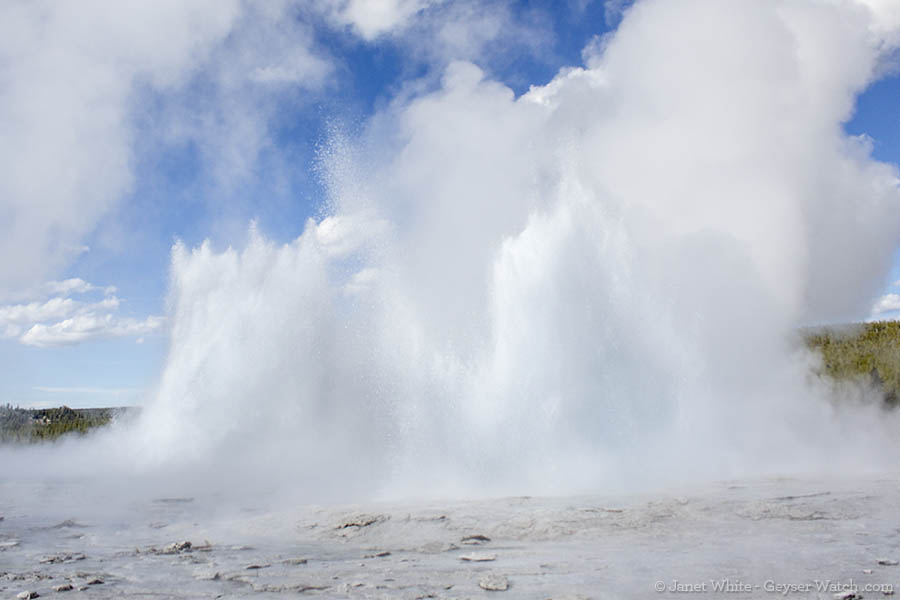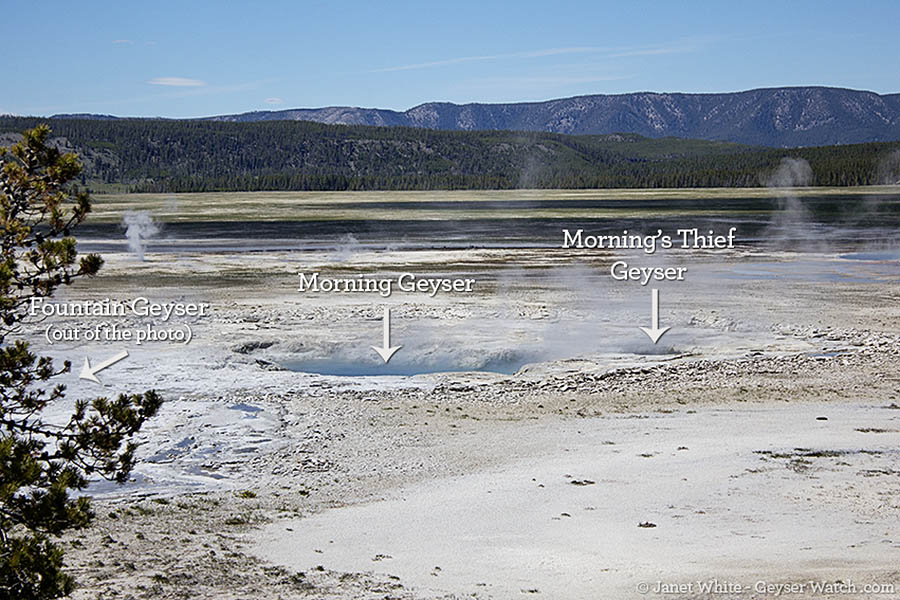 Morning Geyser (left) and Fountain Geyser (right) erupt together on June 5, 2013. (Janet White/GeyserWatch.com)
Morning Geyser (left) and Fountain Geyser (right) erupt together on June 5, 2013. (Janet White/GeyserWatch.com)
By Janet White
On Wednesday, a group of dedicated geyser enthusiasts headed to the Lower Geyser Basin in Yellowstone National Park to await a possible eruption of Morning Geyser near the Fountain Paint Pots. The hours of waiting paid off not only in an eruption of Morning Geyser, but also a rare simultaneous eruption from Fountain Geyser. This became the 9th known dual eruption of these two closely connected geysers in the history of Yellowstone.
Morning erupted for a full 33 minutes before quieting down and allowing Fountain Geyser to finish another hour of the eruption. The total eruption of Fountain Geyser lasted 93 minutes. The early evening light and blue skies dotted with summer clouds made for fantastic viewing conditions. A couple of the bursts from Morning reached 150-200 feet as estimated by knowledgeable geyser gazers.
Morning Geyser reactivated in 2012 to the delight of many after an 18-year dormancy. Reports from Yellowstone Tour Guides, based out of Big Sky, throughout the winter kept up hopes that the eruptions would continue until more viewers could get to Yellowstone to witness the rare geyser. Delightfully, they have, and the electronic data from a data logger on Fountain Geyser has appeared to confirm the tour guide’s observations as accurate. Though without an electronic data logger to collect the temperature data from Morning Geyser itself, eruptions from that data source can only be inferred.
Morning Geyser received its name because it usually erupts in the morning hours, when the wind is calm. But it can erupt at any time of the day when there is little wind. Morning Geyser is one of a handful of geysers known to be affected by the wind as it cools the surface just enough to prevent an eruption. In Morning Geyser’s case, that energy transfers over to its neighbor, Morning’s Thief Geyser.
 Location of Morning Geyser and Morning’s Thief Geyser. (Janet White/GeyserWatch.com)
Location of Morning Geyser and Morning’s Thief Geyser. (Janet White/GeyserWatch.com)
Observations of eruptions have allowed us to gain enough insight to find a pattern that gives us a forecasted window of opportunity for Morning Geyser to erupt. This is the ‘recipe’ many are using:
- Check Geyser Times for the last known eruption of Fountain Geyser.
- Open that entry to find out the duration of that eruption. More than 40 minutes is more encouraging for a Morning Geyser eruption than less than 40 minutes.
- A period of 7.5-9.5 hours following the last eruption of Fountain Geyser becomes the forecasted window of opportunity.
- Arrive about 7 hours after the last eruption of Fountain Geyser and be prepared to wait a few hours. Bring books, or just spend the time chatting. Binoculars are good for spotting convection currents and bubbles on the surface of Morning Geyser’s water (they are usually good signs).
Once there, watch for a rise in the water level that still remains below overflow. This can take some time. Bubbles and upwelling of the water causes convection currents on the surface and are considered a very good sign. If seen, then also pay attention to the wind. Even a pause in the wind can be enough to trigger an eruption. It’s a good sign if you don’t see any steam from Morning’s Thief. No or little steam from Fountain is also good. Some are wondering if the dual eruptions might be more likely if no eruption has happened from Morning’s Thief, Morning or Fountain and 9 hours have elapsed since the last eruption from Fountain.
If Morning Geyser doesn’t erupt, you’ll still get to see the more regular Fountain Geyser, which is a delight in itself and still worth the wait.
Janet White is the creator of GeyserWatch.com and appreciates any reports on unusual or interesting activities by Yellowstone Park thermal features.
